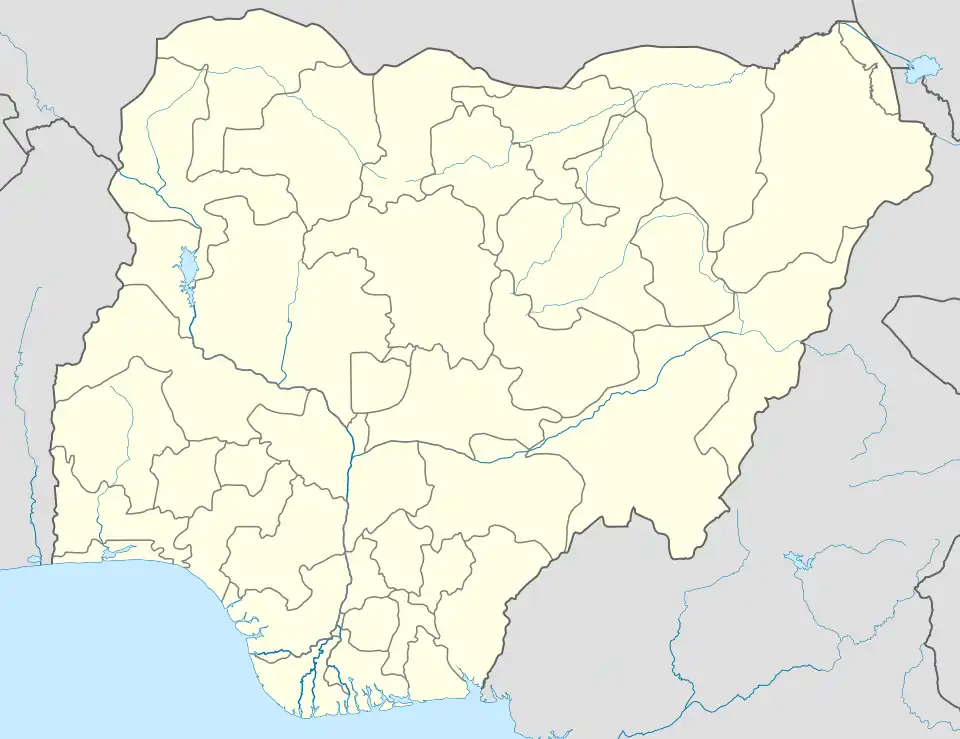Borno Emirate
The Borno Emirate, or Borno Sultanate, is a traditional Nigerian state that was formed at the start of the 20th century. It is headed by the descendants of the rulers of the Bornu Empire, founded before 1000. The rulers have the title Shehu of Borno (var. Shehu of Bornu, Sultan of Borno/u). The traditional emirate of Borno maintains a ceremonial rule of the Kanuri people, based in Maiduguri, Borno State, Nigeria, but acknowledged by the 4 million Kanuri in neighbouring countries.[1]
Borno Emirate | |
|---|---|
 Borno Emirate Location in Nigeria | |
| Coordinates: 11°50′N 13°09′E | |
| Country | |
| State | Borno State |
| Government | |
| • Shehu | Abubakar Ibn Umar Garbai El-Kanemi of Borno |
The current ruling line, the al-Kanemi dynasty, dates to the accession of Muhammad al-Amin al-Kanemi in the early 19th century, displacing the Sayfawa dynasty which had ruled from around 1300.[2]
History
| House of El-Kanemi | |
|---|---|
Nigerian royal dynasty
 The Organa of 1339, quasi-heraldic flag of the rulers of the ancient Kanem empire  The Organa of 1439, quasi-heraldic flag of the rulers of Kanem's successor state, the Borno empire | |
| Parent house | El-Kanemi of Kukawa |
| Current region | North |
| Founded | 1902 |
| Founder | Abubakar Garbai El-Kanemi |
| Current head | Abubakar ibn Umar Garbai El-Kanemi |
| Titles | |
| Style(s) | Royal Highness Highness |
| Members | |
| Traditions | Islam Folk Islam |
| Cadet branches |
|
The old Bornu Empire collapsed in 1893 when the Funj warlord Rabih Zubayr ibn Fadlallah seized power and transferred the capital to Dikwa.[3] When the French, then expanding in West Africa, defeated and killed Rabih they installed Shehu Sanda Kura, a member of the old Bornu dynasty, as the first Shehu of Borno in Dikwa in 1900. In 1901, he was succeeded by his brother, Umar Abubakar Garbai, the ancestor of the current Emirs of Borno. Based on a treaty between the French, Germans, and British, the old Bornu was split up and Dikwa became part of the German colony of Cameroon. The British invited Umar Abubakar Garbai to become ruler of the part falling to the British, and he moved in 1902 first to Monguno and later to Maiduguri. Later Dikwa was transferred to the newly created British Northern Nigeria Protectorate, resulting in two Shehus, the Shehu of Borno based at Maiduguri and the Shehu of Dikwa based at Dikwa.[4]
Rulers
Rulers of the Borno Emirate since the beginning of the colonial period with the title of "Shehu":[4][5]
| Start | End | Ruler |
|---|---|---|
| 1902 | 1922 | Umar Abubakar Garbai ibn Ibrahim |
| 1922 | 1937 | Sanda Kura (d. 1937) |
| 1937 | 1967 | Umar Ibn Muhammad also known as Sanda Kyarimi |
| 1968 | 1974 | Umar Ibn Abubakar Garbai (d. 1974)[2] |
| September 1974 | February 2009 | Mustapha Ibn Umar Kyari Amin El-Kanemi (b. 1924 d. 21 February 2009)[6] |
| February 2009 | Abubakar Ibn Umar Garbai (b. 13 May 1957)[2] |
Local Government Areas in Borno Emirate
Borno Emirate covers fifteen Local Government Areas:
See also
- Bornu Empire
- Kanem Empires
- Nigerian traditional rulers
References
- al-Kanemi dynasty: Sultanate of Borno. Rulers.org, accessed 2009-04-02
- Naija Pundit (6 March 2009). "The intrigues, power play behind the emergence of new Shehu of Borno". The Guardian. UK. Archived from the original on 12 March 2011. Retrieved 8 September 2010.
- "BORNO STATE: Historical Development". Online Nigeria. Retrieved 6 September 2010.
- Isa Umar Gusau and Sharafa Dauda (11 July 2010). "How Germany, Britain and France once shared, ruled Borno – Shehu of Dikwa". Archived from the original on 27 July 2010. Retrieved 6 September 2010.
- "Traditional States of Nigeria". WorldStatesmen.org. Retrieved 8 September 2010.
- "Mustapha Amin El-Kanemi (1924–2009)". ThisDay. 5 March 2009. Retrieved 8 September 2010.
- Nigeria (2000). Nigeria: a people united, a future assured. Vol. 2, State Surveys (Millennium ed.). Abuja, Nigeria: Federal Ministry of Information. p. 106. ISBN 9780104089.